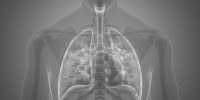
Biomarkes for Detection of Severe Pneumonia
Pneumonia is a type of respiratory infection that affects the lungs. It is caused by various bacteria, viruses, and other microorganisms. The symptoms of pneumonia include coughing, fever, chest pain, and difficulty breathing. It can be a mild illness or a severe and life-threatening condition, especially in young children, the elderly, and people with weakened immune systems. Treatment usually involves antibiotics for bacterial pneumonia, rest, and supportive care. Vaccines are also available to prevent certain types of pneumonia, such as pneumococcal pneumonia. It is important to seek medical attention if someone suspects having pneumonia, as prompt treatment can help prevent serious complications.
Unfortunately, community-acquired pneumonia (CAP) is a leading cause of death among children globally, with millions of hospitalizations annually. Diagnosis and treatment of pediatric CAP can be challenging, and timely intervention is critical to prevent severe disease progression. The underlying molecular mechanisms of CAP are not well understood, making it essential to develop new methods for early assessment of severe cases. Recent studies have used multi-omics approaches to identify potential biomarkers and understand systemic changes associated with disease pathogenesis.
Today we look at a newly published study that used proteomics and metabolomics to profile the host response in serum samples from severe and non-severe CAPs and healthy controls – with interesting results. Their analysis enabled the researchers, among other things, to find two proteins and three metabolites suitable for identifying severe CAP cases, molecular changes that could reflect the occurrence of cell damage.
Brief look at the methods: proteomics and metabolomics
How did the researchers go about it? The study recruited children diagnosed with community-acquired pneumonia (CAP) at the Capital Institute of Pediatrics. The diagnosis of pediatric CAP was based on Chinese Medical Association guidelines, and severe cases were defined based on ICU treatment and positive pressure ventilation.
Clinical information, including blood cell counts and procalcitonin levels, was collected from medical records. Serum samples were collected for proteomic analysis and analyzed using Maxquant, with proteins identified based on specific criteria. Enzyme-linked immunosorbent assay (ELISA) was used to measure changes in protein concentrations.
New biomarker panel identified for severe pneumonia in children through proteomics and metabolomics study
Proteomics and metabolomics were performed on serum samples from 50 participants, including 20 severe CAPs, 15 non-severe CAPs, and 15 healthy controls. The study identified differentially abundant proteins and metabolites in CAP, and a new serum biomarker panel was developed using machine learning algorithms to distinguish CAP from healthy controls and identify severe cases of CAP. The panel included a combination of two proteins and three metabolites.
Furthermore, the researchers observed that the altered serum proteins reflect enhanced immune and inflammatory response, dysregulation of platelets and metabolic processes, and cell death in severe CAPs. Furthermore, pairwise analyses were performed for differentially expressed proteins between each group. The study suggested that metabolic dysregulation is involved in the pathogenesis of CAP, which is augmented with severe disease. Those findings could help in early diagnosis and treatment of severe CAP.
In addition to glucose and nucleotide metabolism, the proteins involved in lipid metabolism were also altered in CAPs. Many apolipoproteins, including APOC1, APOC4-APOC2, APOC3, APOC4, APOF, APOL1, APOM, and APOE, were changed in their expression. Most of these apolipoproteins were down-regulated and associated with macrophage function. Decreased expression of APOC may contribute to macrophage modulation. However, the expression of APOE, APOL1, and APOM was increased in both NS-CAPs and S-CAPs.
Dysregulation of serum APOL1 and APOM has also been reported in COVID-19 patients. Additionally, macrophage-related proteins, such as MARCO, were differentially expressed and correlated with apolipoproteins in terms of function and expression. The study suggests that macrophage function might be impaired in children with severe pneumonia, as many PCs were downregulated in CAPs, especially for S-CAPs.
Summing up: potential biomarkers for severe pneumonia in children, molecular changes and tissue damage mechanism
The study found two proteins (CRP and LBP) and three metabolites that are good candidates for identifying severe CAP cases. The research also identified the molecular changes in CAP sera, which could reflect the occurrence of cell damage in CAP, including lysosome-related proteins, cytotoxicity-related proteins, and phagosome-related proteins.
Moreover, the study observed activation of the complement system and inflammation system in CAPs, as well as cross-talk between glucose metabolism and nucleotide metabolism. The researchers believe that activation of the cell death pathway, the inflammatory response, and a dysregulated complement, coagulation cascade, and platelet function cause tissue damage in children with CAP.